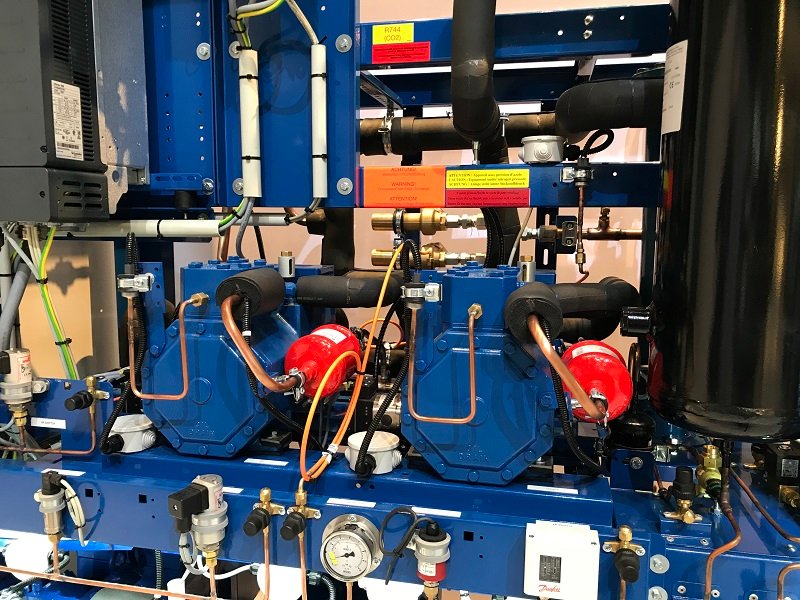CO2 Gains Ground in Industrial Refrigeration Applications
Industrial refrigeration is experiencing its biggest disruption in decades as carbon dioxide (CO2 / R744) systems surge past traditional boundaries, challenging ammonia's long-standing market dominance while regulatory pressure mounts against fluorinated alternatives. What's driving this shift, and what's holding it back?
Industrial Adoption Accelerates
The industrial adoption of transcritical CO2 systems is accelerating rapidly across major markets. According to the 2024 ATMOsphere Natural Refrigerants: State of the Industry market report, Europe now hosts approximately 4,900 industrial sites using CO2 refrigeration technology, representing a remarkable 48% increase from 3,300 sites in December 2023. These industrial installations account for 5.1% of Europe's estimated total of 95,600 transcritical CO2 sites.
North America demonstrates even more explosive growth rates, with 870 industrial sites using transcritical CO2 in 2024 – a 74% increase from 498 sites in 2023. This includes 380 sites in the US (up from 208) and 490 in Canada (up from 290). Industrial applications now represent 17% of North America's total CO2 installations, a significantly higher proportion than Europe's 5.1%.
The growth trajectory shows consistent acceleration. European industrial CO2 installations have tripled since March 2021, when only 1,640 sites used the technology, while North American adoption has gained particular momentum in recent years.
Competing with Established Technologies
In the industrial refrigeration market, CO2 is increasingly challenging ammonia, a natural refrigerant that has long dominated large-scale industrial applications.
Ammonia's Continued Dominance

This dominance is well-founded, according to industry experts. Jeffrey Hinson, Vice President US at CIMCO Refrigeration, North America’s largest industrial refrigeration contractor, confirms that ammonia remains the most common refrigerant in industrial applications in the US. "It is a known refrigerant that is established in the industry. It is very efficient to operate and has the range for large tonnage applications and temperature ranges," he explains.

Wynand Groenewald, President of US-based CO2 engineering consultants Future Green Now, reinforces this assessment: "Ammonia still prevails as the top used refrigerant, as the facilities in the US are just so big. Central ammonia plants remain the go-to solution for large capacity and process facilities."
Additionally, Groenewald notes that contractor preferences often reinforce this status quo beyond technical merit alone: "If it were up to industrial contractors, it would all be ammonia.”
CO2's Market Expansion

Despite this entrenched dominance of ammonia, CO2 is making significant inroads across various industrial applications. Andre Patenaude, Director of Solutions Strategy at Copeland, notes that "CO2 continues to play an increasingly pivotal role in industrial refrigeration, with many trends reflecting what's happening in commercial markets. ESG [Environmental, Social, and Governance] goals are driving refrigerant decision-making, and the transition from HFCs is viewed as inevitable."
The drivers behind CO2's expansion extend beyond corporate sustainability initiatives to practical considerations around safety, regulatory compliance, and market dynamics. This shift is also changing the competitive landscape. Hinson observes how the market structure itself is evolving: "Smaller mechanical contractors are getting into the business, creating a commodity market."
Market Segmentation by Scale
This CO2 expansion isn't happening uniformly across all industrial applications. Hinson observes that CO2 cold storage warehouses are becoming more prevalent at the smaller scale of 200,000 square feet and below. However, processing plants are not as common due to the capacity of the system required or other complexities.
Rather than wholesale substitution, this segmented adoption creates strategic positioning where CO2 and ammonia serve distinct applications. Groenewald provides a comprehensive view of this market evolution: "CO2 has been making a significant impact in the industrial space. There is definitely a move to replace facilities that would have predominantly used HFCs with CO2 systems, so the adoption of CO2 in the industrial space is clearly evident.”
Crucially, this growth targets HFC replacement rather than ammonia displacement, reflecting market segmentation rather than direct competition between natural refrigerants.
Groenewald notes that facilities in the US are simply so big that ammonia remains ideal for many applications, but CO2 is finding its niche: “Low-charge ammonia has quieted down in my opinion; I feel that CO2 is taking more of the space where low-charge ammonia would be considered, while central ammonia plants remain the go-to solution for large-capacity and process facilities.”
Regulatory Drivers Reshaping the Market
The dramatic growth in industrial CO2 adoption stems largely from regulatory pressure that varies significantly between the EU’s comprehensive approach and America’s state-by-state implementation. Understanding these regulatory frameworks is essential to explaining the market segmentation patterns across different regions.
EU Regulations: A Comprehensive Framework
The EU’s revised F-gas Regulation, which became law on March 11, 2024, establishes the world’s most comprehensive framework for eliminating fluorinated gases.

Giacomo Pisano, Sales Manager at Italian compressor manufacturer Dorin, explains the regulation’s impact: “Thanks to the new F-gas Regulation, synthetic refrigerants are now much more challenged in small- and medium-sized industrial applications, opening the door to natural refrigerants, especially CO2.”
Key Industrial Regulatory Milestones:
-
2027: New chillers up to 12 kW capacity prohibited from using f-gases with Global Warming Potential (GWP) ≥150; larger chillers limited to GWP ≤750
-
2032: Complete ban on fluorinated refrigerants in all chillers up to 12 kW capacity
-
2050: Total phase-out of f-gases
The regulation includes important exceptions for “equipment required to meet safety requirements at the site of operation,” acknowledging the complex safety considerations in industrial applications.
The EU regulation also explicitly links f-gases to PFAS (per- and polyfluorinated substances), stating that some fluorinated greenhouse gases “are proven to or suspected to degrade into PFAS.” This connection adds urgency to the transition away from HFO refrigerants toward natural alternatives like CO2 and ammonia.
The revised regulation also mandates that member states establish certification programs for technicians working with natural refrigerants, addressing a critical skills gap in the industrial sector where CO2 technology is less familiar than established ammonia systems.
US Regulations: State-Led Innovation with Federal Uncertainty
The US operates under a fragmented regulatory approach that creates both compelling drivers and hesitation among industrial operators. Regulatory certainty – or the lack thereof – plays a crucial role in industrial CO2 adoption patterns, creating varied adoption patterns across different states.
This regulatory complexity creates a two-track market where some states drive rapid adoption while others maintain a wait-and-see approach, making regulatory future-proofing a critical consideration for industrial operators planning long-term refrigeration investments.
While the federal American Innovation and Manufacturing (AIM) Act provides a baseline structure through 2028, leading states are implementing far more aggressive timelines that directly impact industrial refrigeration choices:
New York has set some of the most stringent requirements, with finalized HFC regulations that include specific industrial provisions:
-
Ice rinks: F-gases with GWP20 >580 banned January 1, 2026; GWP20 >10 banned January 1, 2030
-
All chillers: F-gases with GWP20 >20 banned January 1, 2030
Washington State directly targets industrial refrigeration with comprehensive equipment restrictions:·
-
2025: New commercial and industrial refrigeration equipment (excluding chillers) must use refrigerants with GWP ≤150
-
2029: Retrofit requirements and industrial chillers limited to GWP ≤750
-
Fee structure: Annual fees for industrial systems using high-GWP refrigerants with charges above 200lbs
California combines regulatory pressure with financial incentives through its $65 million F-gas Reduction Incentive Program (FRIP), specifically targeting industrial applications:
-
Industrial process refrigeration and cold storage facilities with systems using GWP >1,800 refrigerants are eligible for replacement funding
-
$5 million dedicated to industrial process refrigeration replacements
-
$3 million for cold storage and other refrigeration applications
-
Eligibility requirements effectively mandate ultra-low-GWP alternatives like CO2 (GWP of 1) for funded replacements
Market Forces: Drivers and Barriers
Beyond regulatory frameworks, industrial CO2 adoption faces additional market forces that create both compelling drivers and significant barriers.
Barrier: Knowledge Gaps
The industry faces significant human capital challenges, with the expertise gap manifesting at multiple levels, from operators to contractors. Patenaude explains that while many operators in the US are aware of CO2 refrigeration, “most haven’t had an opportunity to evaluate the performance of CO2 systems for themselves. Thus, many have ‘new to me’ reservations about CO2.”
The knowledge gap extends to awareness of technological advances. Industrial operators may also be unaware that “the technological landscape has advanced to facilitate the use of CO2 in industrial refrigeration, including compression, controls, valves, and associated system components,” Patenaude notes.
Manufacturing constraints compound these challenges. Pisano notes regional capacity limitations, especially in the US: “The main barrier is a lack of manufacturing capability – there are not enough OEMs to fulfill the actual market requirements.”
Recognizing these expertise gaps, manufacturers are developing comprehensive support programs to address the knowledge deficit in industrial CO2 applications. “We’re committed to helping industrial contractors and system designers level up their CO2 skillsets,” Patenaude explains. “Our engineering teams are actively collaborating with them to design and install systems, easing the learning curve and positioning their operations for long-term success.”
This support extends to implementation strategies designed to reduce adoption risk. Patenaude recommends a measured approach: “For operators looking to make the shift, we recommend familiarizing yourself with CO2 refrigeration through smaller-scale field trials. This is an excellent way to test the latest CO2 technologies and get the validation needed to pursue the installation of a larger CO2 refrigeration plant.”
Driver: Safety and Urbanization Concerns
The primary driver in industrial applications differs markedly from commercial motivations. While commercial adoption often stems from corporate sustainability goals, industrial adoption is often driven by practical safety considerations. Patenaude explains: “Urbanization has brought more people closer to what were once remote cold storage facilities, leading local authorities to express reservations about the use of ammonia. As a non-toxic and non-flammable A1 refrigerant, CO2 alleviates safety concerns.”
This urbanization trend is reshaping industrial refrigeration decisions across both regions. Ammonia installations face increasing regulatory and documentation requirements, complicating their operation and making CO2’s safety profile increasingly attractive for facilities in populous areas.
Driver: Larger Compressor Sizes
The expansion of CO2’s market reach depends heavily on technological developments that address capacity limitations, with larger compressor development representing the most critical advancement for industrial viability. Manufacturers across both sides of the Atlantic are investing heavily in scaling up equipment to compete with ammonia’s established capacity range.
Groenewald highlights that “larger transcritical CO2 compressors are entering the market and opening up discussions for large-capacity CO2 facilities.” This represents a fundamental shift in CO2’s industrial potential, as he notes: “The biggest innovations are the larger compressors and components.”
The availability of larger compressors enables new possibilities. Patenaude highlights Copeland’s new subcritical and transcritical single-screw CO2 compressors, which enable the construction of industrial-grade CO2 refrigeration plants. “These robust CO2 solutions support high tonnage capacities while requiring fewer compressors, greatly simplifying the use of CO2 in industrial refrigeration.”
However, Groenewald notes that innovation has been limited beyond scaling: “Sadly, the technology has mostly stayed the same. I think the US is in a state of making it work and figuring it out, rather than being focused on new technology.”
Driver: Availability of Modular Equipment

Oliver Javerschek, Project Manager at German manufacturer BITZER, brings perspective from Europe's mature industrial CO2 market, explaining how modular approaches benefit industrial applications: "The modular design of systems with multiple compressors can offer advantages in industrial-scale applications. On one hand, it is interesting for the overall concept to divide different temperature levels, such as commissioning and storage, between two systems. On the other hand, the part-load efficiency of the modular systems is high, as capacity control can be modulated better with several compressors than with one large compressor."
This approach addresses the unique load profiles of industrial facilities. Javerschek explains that "distribution centers or food processing plants are typically characterized by high load in the medium-temperature and low-temperature stages during stock handling and production, but for the rest of the time, partial load is required with only one-third to one-fifth of the nominal capacity." This load variation makes modular systems with superior part-load performance valuable.
However, despite efficiency opportunities, Javerschek notes that "industry likes to use standard solutions, such as modular system technology with flash gas bypass and direct expansion evaporation. The increase in efficiency is achieved by using more efficient heat exchangers or compressors rather than complex efficiency-improving technologies that increase technical effort."
Conclusion: At a Crossroads
The industrial refrigeration sector stands at a pivotal moment. While CO2's 48% growth in Europe and 74% surge in North America signal genuine momentum, these numbers mask a more nuanced reality: CO2 isn't simply replacing synthetic refrigerants in industrial applications; it's carving out new market segments while coexisting with ammonia's continued dominance.
The path forward hinges on three critical developments. First, continued scaling of compressor technology to reach the capacity thresholds where ammonia currently reigns supreme. Second, comprehensive workforce development to address the knowledge gap that remains the primary barrier in contractor communities. Third, regulatory frameworks that acknowledge industrial refrigeration's complexity while maintaining pressure toward lower-GWP solutions.
The trajectory suggests industrial CO2 adoption will follow a different pattern than commercial markets. Rather than wholesale replacement, segmented growth seems likely, where CO2 captures medium-scale applications (particularly in urban areas where ammonia faces restrictions) while ammonia maintains its stronghold in large processing facilities.
For industrial operators, the question isn't whether to choose CO2 or ammonia, but rather understanding where each technology delivers optimal performance in an increasingly regulated landscape.
Read more about commercial CO2 trends in the EU and US.
Learn how transcritical and subcritical cycles operate, why CO₂ has a unique thermodynamic profile, and how it compares with HFCs, HFOs, ammonia, and hydrocarbons.
